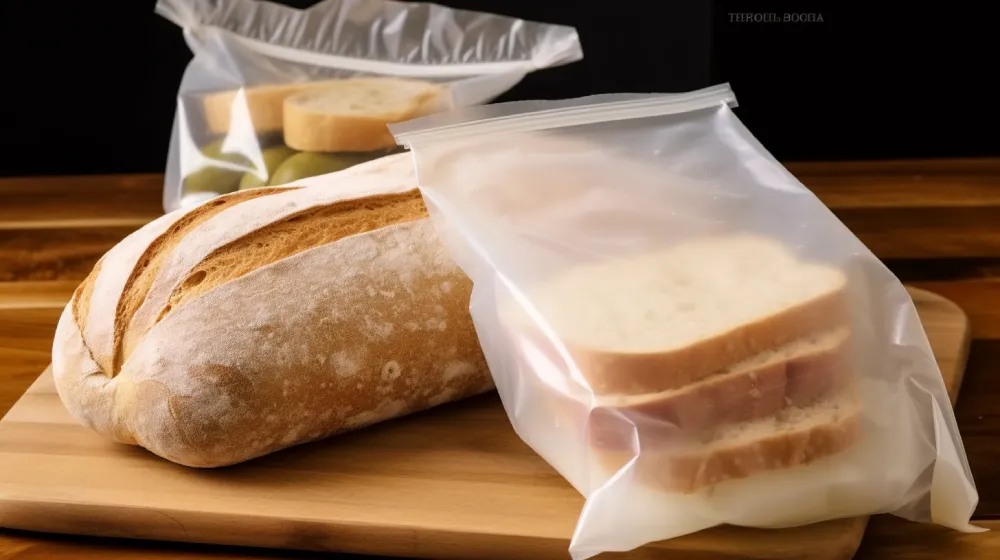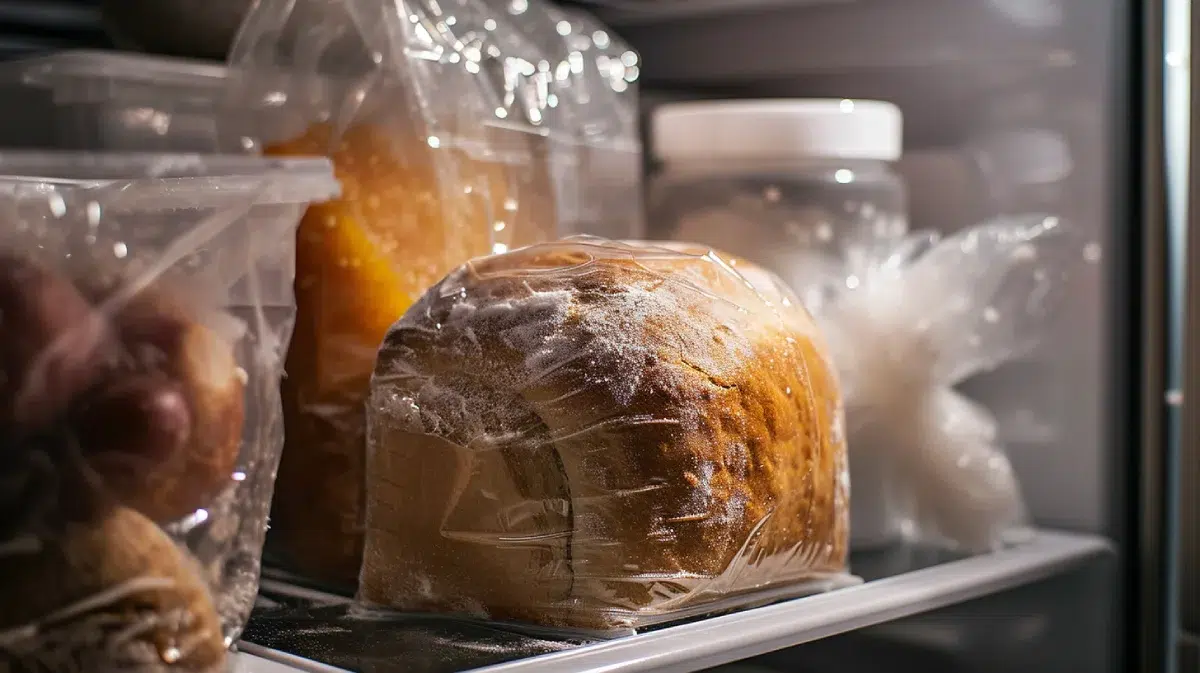Can I Freeze Sourdough Bread? Getting the Best Flavor from Freezing and Thawing
If you’re here, I guess you’re probably wondering about freezing that lovely loaf of sourdough bread you just baked or bought. You absolutely can, and it’s pretty easy.
Many of us love sourdough’s unique tang and hearty crust, but sometimes there’s just too much to finish. If you’re a fan of toast and want to freeze pre-sliced bread for a quick breakfast or want to freeze a whole loaf to preserve its full flavor, freezing is a smart way to keep that homemade taste and texture just right for later.
You’ll always have some tasty bread on hand without wasting anything. This method not only prolongs the shelf life of the bread but also locks in its distinct freshness, allowing you to enjoy a slice of homemade sourdough whenever the craving strikes.
And, you know what’s cool? Your bread will be a bit healthier, too. Yes, you heard me right.
Freezing your bread helps form resistant starch, which has been shown to lower glycemic responses. So, by freezing your loaf, you’re not just stretching its lifespan; you’re also making a choice beneficial for your health.
I’m here to walk you through the whole process of freezing your sourdough, from the best way to wrap it up to how to thaw it so you can have that yummy slice of sourdough toast whenever you feel like it.
Why is Freezing Sourdough Bread a Great Idea?
Freeze your sourdough bread – it’s a great idea! Here’s why:
Preservation of Quality and Taste
Freezing sourdough bread helps maintain its original flavor and texture. This means that even after being frozen and thawed, the bread still offers the delightful taste and texture that sourdough is known for.
Reduction in Food Waste
You can significantly reduce food waste by freezing sourdough bread. This is especially beneficial for those who bake in large batches or find themselves with more bread than they can consume quickly.
Convenience and Variety in Meal Selection
Frozen sourdough bread on hand adds convenience and variety to your meal planning. It allows you to enjoy sourdough bread anytime without frequent baking or purchasing. It is ideal for those who bake in bulk or want to have homemade bread.
Duration of Freezing (Up to 2 Months)
Sourdough bread can be stored in the freezer for up to two months without a significant loss in quality, providing a long window for consumption and ensuring that you have good-quality bread available whenever needed.
Health and Nutritional Aspects
As a health-conscious foodie, I found out something you’ll love. You’re in for a treat if you’re obsessed with sourdough bread like I am.
It’s not just about keeping your sourdough fresh or satisfying your cravings when you freeze it. You might not know that it’s got some great health perks. I’ll show you.
Formation of Resistant Starch: Freezing sourdough bread leads to the formation of resistant starch, which is not easily broken down in the gut. This can positively impact blood sugar levels, making it a beneficial choice for those monitoring their glycemic response.
The formation of resistant starch primarily occurs during the thawing process, not while the bread is frozen. When frozen bread is thawed, the molecular structure of the starch changes. This altered structure creates resistant starch, which resists digestion in the small intestine and functions similarly to dietary fiber.
Health Benefits for Glycemic Control: The resistant starch formed through freezing can help manage glycemic control. This is particularly advantageous for individuals with diabetes or those looking to maintain stable blood sugar levels.
Study Findings on Glycemic Response: Research has indicated that frozen and reheated sourdough bread can lead to lower glycemic responses than fresh bread. This suggests that freezing and reheating can alter the bread’s impact on blood sugar levels.
Long-Term Health Benefits: Regularly consuming foods with a lower glycemic index, like frozen and reheated sourdough bread, may reduce the risk of developing chronic conditions such as type 2 diabetes and cardiovascular diseases. This makes frozen sourdough a strategic inclusion in a health-conscious diet.
Maintains Satiety: Sourdough bread with higher resistant starch may promote a feeling of fullness, helping with weight management.
How to Freeze Sourdough Bread: A Step-Step Guide
The unique aspect of sourdough bread lies in its specific enzymes, distinct from those found in other types of bread. These enzymes make sourdough bread suitable for freezing, but only once.
Sourdough bread is made using a fermentation process involving natural yeasts and bacteria, which results in the development of specific enzymes not present in other types of bread. These enzymes contribute to the distinctive flavor and texture of sourdough.
When you freeze sourdough bread, these enzymes are halted in their activity, preserving the bread’s current state. However, once thawed, these enzymes become active again and break down the bread’s starches and gluten. This process alters the bread’s structure and flavor.
Refreezing sourdough bread after it has been thawed causes further breakdown of its structure due to ice crystal formation and the activity of these enzymes. This can lead to a noticeable decrease in quality, making the bread less enjoyable in texture and taste. Hence, sourdough bread can only be frozen once.
Let’s go through the whole freezing and thawing process, step by step, so you can enjoy your bread at its best, whether today, tomorrow, or a few weeks from now.
Cooling Before Freezing
Let your sourdough cool completely to room temperature first. It’s important to do this because it prevents condensation inside the packaging, which can ruin the bread’s texture when you thaw it. Cooling the bread ensures the inside is as good as the outside, protecting the crumb structure and crust integrity.
When slicing sourdough bread, timing is everything for the perfect texture and flavor. Unlike other breads, sourdough requires a longer cooling period before slicing.
For instance, a typical 1.5 lb loaf of sourdough needs at least 4 hours to cool, and if it contains rye flour – known for high moisture retention – the cooling time extends to 24-48 hours. The denser the bread, like wholegrain loaves, the longer the cooling time required.
Here’s a quick guide to cooling times based on the type of sourdough bread:
- Small dinner rolls: 30 minutes
- Small white loaf (1 lb): 4 hours
- Large white loaf (1.5 lb): 8 hours
- Small wholegrain loaf (1 lb): 5 hours
- Large wholegrain loaf (1.5 lb): 10 hours
- Small rye loaf: 24 hours
- Large rye loaf: 48 hours
Cutting the bread too early can result in a moist, gluey texture and a squashed structure, making it difficult to slice properly. Cutting it too late, however, leads to a drier, tougher bread that stales faster. The key is to wait just long enough for the bread to complete its baking process and stabilize its texture, but not so long that it loses its moistness and freshness.
Slicing for Easy Use
Once your bread is cool, slice it up into portions. This makes it easy to use later, whether after a quick snack or a hearty sandwich. Here’s how to do it:
Uniform Slices: Cut even slices, not too thin, to keep the structure after thawing.
Parchment Barrier: Put parchment paper between slices to keep them from sticking.
Air-Tight Packaging: Wrap your slices in something airtight to protect against freezer burn and keep the flavor locked in.

I’ve found the best method to keep my sourdough bread perfect in texture and flavor is to slice it, flash freeze the slices, and then store them in freezer-safe bags with the air squeezed out. This way, whenever I want a slice or two, I instantly toss them in the toaster and enjoy fresh sourdough bread. It’s super convenient and tastes just like it’s fresh out of the oven.
Wrapping
Now, let’s wrap it up.
- Start with plastic wrap, covering every inch to keep the moisture in.
- If you’re working with slices, remember to put parchment paper between them.
- Then, add a layer of aluminum foil in the freezer for extra protection against any odors or temperature changes.
- Finally, pop your wrapped bread into a heavy-duty freezer bag, squeeze out the air, seal it tight, and label it with the freezing date.
Using Freezer-Safe Containers

- Choose containers that can handle the cold without cracking, like heavy-duty plastic or glass.
- Make sure they have tight-fitting lids or seals to keep the air out and the bread fresh.
- Pick a size that fits your bread snugly to reduce the risk of freezer burn.
- Squash the air out of the bag before sealing it. You can use a straw or your hands to suck out any extra air in the bag.
Using Plastic Bags

Avoid using regular plastic bags, as they are not freezer-friendly and will cause the bread to dry out quickly. Use zip-lock or heavy-duty freezer bags and wrap them tightly around the bread, pressing out any excess air.
Labeling and Tracking
Label your bread with the freezing date and the type of bread. This helps you track what you have and use the oldest items first.
Before freezing, write the date and type on a freezer-safe label or masking tape. You can also keep a freezer inventory and mark off items as you use them. This way, you’ll always know what bread is available and when to restock.
Freezing (below 0°C or 32°F) vs. Refrigerating (above 0°C or 32°F and below room temperature)
How we store it can make a huge difference when dealing with sourdough bread. If you’re like me, figuring out whether to freeze or put it in the fridge can be a dilemma. But I’ve cracked the code after some trial and error.
How Long It Lasts for Us: I’ve found that if I freeze our sourdough, it can last for several months, which is awesome compared to just refrigerating it. It’s only at its best in the fridge for about a week or less.
Freezing and Staling Process: When you freeze sourdough bread, the low temperatures halt the staling process by preventing the crystallization of starch. This means the bread retains its moisture and texture, effectively ‘pausing’ the bread in its current state until it’s thawed.
On the other hand, refrigeration can speed up the staling process due to faster starch retrogradation, causing the bread to dry out and harden more quickly.
Mold Isn’t an Issue: This is a big plus for freezing. It’s easy for bread to get moldy in the refrigerator if left too long, especially if it’s been forgotten for a while.
Texture Matters: Here’s something you’ll notice: bread that’s been frozen and then thawed almost tastes fresh again. But bread from the fridge? It tends to lose its softness and ends up too hard for me.
Best Temperature Tip: So, what I do now is freeze our sourdough at temperatures below 0°C (32°F). This keeps it delicious for a lot longer. I’d recommend you use the fridge only for short-term storage to avoid your bread getting stale too fast.
Practical Approach: While freezing is great for long-term storage, I get that you might not want months-old bread. Keeping it in the fridge is fine as long as you plan on eating it within a few days. Just remember, if you’ve got more bread than you can eat in that time, the freezer is your friend.
So, there’s a balance to strike. Put the bread you’ll eat soon in the fridge, and freeze the rest to keep it fresh. You get freshness and convenience.
How do You Thaw and Reheat the Frozen Sourdough Bread?
Let’s keep it simple to get that delicious sourdough bread back to its best after being frozen. Follow these steps to thaw and reheat without losing any of that yummy flavor or texture:
Night-Before Move: Move the bread from the freezer to the fridge the night before you need it. This slow thawing method keeps everything just right.
Keep It Gradual: Let the bread thaw in the fridge at its own pace. Rushing it at room temperature can make it soggy, and no one likes soggy bread!
Quick Oven Refresh: If you’re in a hurry, after thawing, pop the bread in the oven for a short while to bring back that fresh-baked feel.
To bring back that fresh taste, follow these reheating tips:
Oven Time: When you’re ready to eat, some reheating works like magic. Preheat your oven to a moderate temperature, around 350°F (175°C). If the bread is still damp from the fridge, you can briefly ‘air it out’ at room temperature before placing it in the oven.
Optional Moisture: If the bread feels excessively dry, lightly mist it with water before reheating. However, this should be done very sparingly. A light spray is often enough.
Baking: Place the bread directly on the oven rack or a baking sheet. Heat it for about 10-15 minutes, or until it’s warmed through and the crust has crisped up to your liking.
Serving: Let the bread cool slightly after removing it from the oven. This resting period allows the interior to set and prevents it from being gummy.
For a Whole Loaf: If reheating the entire loaf, let it warm to room temperature first, then wrap it in foil and put it in the oven. This way, it heats evenly and stays moist.
For Slices: If you only have a few slices, they can go straight into the toaster or oven for a quick crisp-up.
How do You Tell If That Frozen Sourdough Bread Has Gone Bad?
Determining if frozen sourdough bread has gone bad requires a few steps, especially since freezing can conceal typical signs of spoilage.
- Inspect the bread for freezer burn, indicated by dry, leathery patches or discoloration on the crust or surface. Freezer burn doesn’t render the bread unsafe but affects its taste and texture.
- After thawing the bread, examine it closely for mold growth. Mold won’t develop in the freezer, but if the bread was beginning to mold before freezing, it will become apparent once thawed.
- Look for any unusual spots, especially those with green, white, or black colors. Assess the bread’s smell and texture after thawing; any off odors or a significantly altered texture could also indicate that the bread is no longer good to consume. Remember, while freezing extends the life of your sourdough bread, it’s still important to check these factors to ensure its quality and safety when you’re ready to use it.
How to Use Your Stale Sourdough Bread? Is It Gone for Good?
I know it’s a bit disheartening to find your sourdough bread has gone stale, but there are many creative ways to use it.
- Stale sourdough makes excellent croutons for salads or soups. Cube the bread, toss it with olive oil, garlic, and herbs, and bake until crispy.
- It’s also perfect for bread pudding, where its sturdy texture absorbs the custard beautifully.
- Another great option is to make French toast, as the stale bread holds up well to soaking in the egg mixture.
- You can also grind stale sourdough into breadcrumbs for use in meatballs, coatings for fried foods, or as a topping for casseroles.
- Don’t forget about Panzanella, the classic Italian bread salad, where stale bread is revitalized with juicy tomatoes, fresh herbs, and a zesty dressing.
These ideas reduce food waste and allow you to enjoy your sourdough in new, tasty forms.
Are There Any Special Considerations for Freezing Sourdough Bread With Mix-Ins?
When freezing sourdough bread that includes mix-ins like olives, nuts, or dried fruit, a few extra steps are needed to ensure its quality remains intact.
Because ingredients like olives can add more moisture to the bread, it’s important to let the bread cool completely and dry before freezing to prevent moisture crystallization. Be aware that nuts may soften slightly during freezing, altering their texture.
If you’re slicing the bread, do so evenly, as the mix-ins can make this a bit tricky, but uniform slices ensure better thawing and reheating.
Wrap the bread tightly in plastic wrap or aluminum foil and then place it in a freezer-safe bag, squeezing out as much air as possible to prevent freezer burn and protect the flavor and texture of the bread and the mix-ins.
Thaw the bread slowly in the refrigerator, especially if it contains high-moisture mix-ins, to maintain structure and prevent sogginess.
And, when reheating, remember that ingredients like fruits and olives can heat up differently, possibly affecting the overall reheating time.
Love Sourdough Bread? Freeze It for Easy and Delicious Enjoyment
So, we’ve walked through the ins and outs of freezing sourdough bread, and it turns out it’s pretty easy and definitely worth it. You’ve learned that, yes, you can freeze your sourdough, and it’s a great way to make sure none of that delicious, tangy bread goes to waste.
We’ve covered the basics: how to wrap it up to keep it fresh in the freezer, the choice between freezing whole loaves or pre-sliced pieces for quick use, and the best ways to thaw and reheat it so it tastes just like it came out of the oven.
Now you’ve got the know-how to always have that perfect slice of sourdough on hand, so you can make a tasty sandwich or a warm, buttery toast whenever you want. Laugh and share joy with sourdough bread, a culinary wonder that nourishes our souls.







